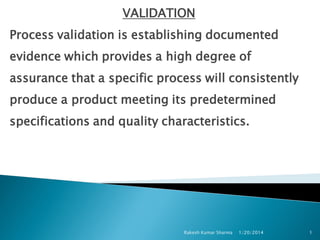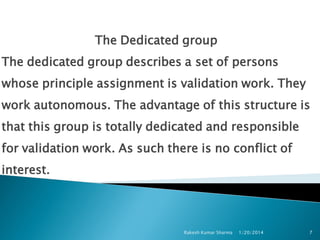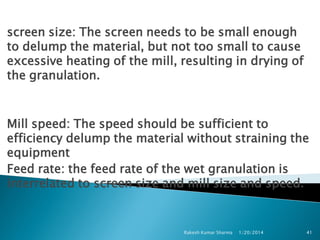The document discusses process validation for pharmaceutical manufacturing. It provides details on validation master planning, organizing validation work, process characterization, validation protocols, qualification of facilities and equipment, and validation options like prospective, concurrent and retrospective validation. Specific processes like wet granulation, tableting and coating are also discussed with parameters to consider for validation.

















![Pre-requisites of Validation
(Facilities, Systems and Equipment)
Qualification is pre-requisite of validation. The
qualification includes the followings.
Design qualification [DQ]: In this qualification,
compliance of design with GMP should be
demonstrated.
The principles of design should such as to achieve
the objectives of GMP with regards to equipment.
Rakesh Kumar Sharma
1/20/2014
18](https://image.slidesharecdn.com/pharmaceuticalvalidation-140120065036-phpapp01/85/Pharmaceutical-Process-validation-18-320.jpg)
![Installation qualification [IQ]: Installation
qualification should be carried out on new or
modified facilities, systems and equipment.
The following points should be included in the
installation qualification.
Checking of installation of equipment, piping,
service and instrumentation.
.
Rakesh Kumar Sharma
1/20/2014
19](https://image.slidesharecdn.com/pharmaceuticalvalidation-140120065036-phpapp01/85/Pharmaceutical-Process-validation-19-320.jpg)

![Operational qualification [OQ]:
OQ should follow IQ.
OQ should include the following
Test(s) developed from the knowledge of the
process(s), system(s) and equipment.
Defining lower and upper operating limits.
Rakesh Kumar Sharma
1/20/2014
21](https://image.slidesharecdn.com/pharmaceuticalvalidation-140120065036-phpapp01/85/Pharmaceutical-Process-validation-21-320.jpg)

![Performance Qualification [PQ]: After IQ and OQ
have been completed, the next qualification that
should be completed is PQ.
PQ should include the following
Test using production materials, substitutes or
simulated products.
These can be developed from the knowledge of the
process and facilities, system or equipment.
Rakesh Kumar Sharma
1/20/2014
23](https://image.slidesharecdn.com/pharmaceuticalvalidation-140120065036-phpapp01/85/Pharmaceutical-Process-validation-23-320.jpg)






































